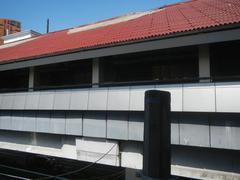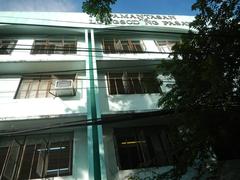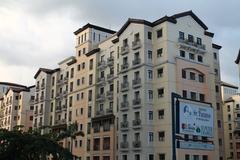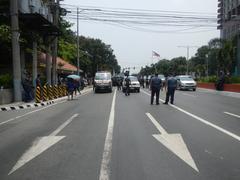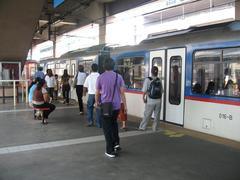Comprehensive Guide to Visiting Pasay, Metro Manila, Philippines
Date: 13/08/2024
Captivating Introduction
Welcome to Pasay, a city where history and modernity intertwine in a vibrant dance, creating a unique tapestry for every visitor to explore. Nestled in Metro Manila, Pasay was once a part of the Namayan Kingdom, a pre-colonial hub of agriculture and trade. The name ‘Pasay’ itself is derived from Dayang-dayang Pasay, a princess who left an indelible mark on this area (Wikipedia). Fast forward to the Spanish colonial period, and the city’s landscape began to shift dramatically. In 1571, Miguel López de Legazpi claimed the Rajahnate of Maynila and its environs for Spain, and by 1863, the town became known as ‘Pineda’ in honor of Don Cornelio Pineda (Wikipedia). The American colonial period brought rapid urbanization, transforming Pasay from a swampy bayside area into a residential haven. By 1918, Pasay’s population had swelled to 18,697, attracting prominent Filipino families, including future president Manuel L. Quezon (Wikipedia). During World War II, Pasay was declared an open city by General Douglas MacArthur and became part of the City of Greater Manila. The post-war period saw Pasay flourish anew, hosting the Miss Universe 1974 pageant and marking its place on the global stage (Wikipedia). Today, Pasay continues to thrive, driven by its dynamic cultural and economic contributions (Vigattin Tourism).
Table of Contents
- Discover Pasay, Metro Manila: Where History Meets Modernity
- A Glimpse into the Past
- Spanish Colonial Footprints
- The American Influence
- Wartime Resilience
- Post-War Renaissance
- Cultural and Economic Pulse
- Hidden Gems and Local Secrets
- Sensory Delights
- Must-Visit Attractions
- Local Lingo and Cultural Etiquette
- Seasonal Highlights and Fun Facts
- Interactive Itineraries
- FAQs
- Visitor Tips for Pasay, Metro Manila, Philippines
Discover Pasay, Metro Manila: Where History Meets Modernity
A Glimpse into the Past
Welcome to Pasay, a city that seamlessly blends its rich historical tapestry with the buzz of modern life. Did you know that Pasay was once part of the Namayan Kingdom, a thriving pre-colonial hub of agriculture and trade? The name ‘Pasay’ itself is believed to originate from Dayang-dayang Pasay, a princess whose wisdom and grace left an indelible mark on the area (Wikipedia).
Spanish Colonial Footprints
Fast forward to the Spanish colonial period, and Pasay’s landscape began to shift dramatically. In 1571, Miguel López de Legazpi claimed the Rajahnate of Maynila and its environs for Spain. The Augustinians took over in 1727, transferring Pasay from Santa Ana de Sapa to Malate. The town became known as ‘Pineda’ in 1863 in honor of Don Cornelio Pineda, a horticultural benefactor (Wikipedia).
The American Influence
The American colonial period brought rapid urbanization to Pasay. Imagine a swampy bayside area transformed into a residential haven. By 1918, Pasay’s population had swelled to 18,697, attracting prominent Filipino families, including future president Manuel L. Quezon (Wikipedia).
Wartime Resilience
World War II tested Pasay’s mettle. Declared an open city in 1941 by General Douglas MacArthur, Pasay became part of the City of Greater Manila during the war. Many brave Pasayeños, like Jose P. Maibag and Carlos Mendoza, played crucial roles in resisting Japanese occupation (Wikipedia).
Post-War Renaissance
The post-war period saw Pasay flourish anew. President Ferdinand Marcos appointed Imelda Marcos as governor of Metro Manila in 1975, leading to significant urban development. Pasay hosted the Miss Universe 1974 pageant, marking its place on the global stage (Wikipedia).
Cultural and Economic Pulse
From farming and fishing to manufacturing and beyond, Pasay has always been a vital economic player in Metro Manila. The city’s transformation continues, driven by its dynamic cultural and economic contributions (Vigattin Tourism).
Hidden Gems and Local Secrets
- Cartimar Market: This bustling market is a local favorite for bargain shopping, exotic pets, and fresh produce.
- Libingan ng mga Bayani: A serene cemetery honoring Filipino heroes, offering a quiet escape and a dose of history.
- Blue Bay Walk: A lesser-known spot with a charming mix of dining, shopping, and entertainment options.
- San Isidro Labrador Church: A quaint church with beautiful architecture and a peaceful ambiance.
Sensory Delights
Feel the warm sea breeze at Manila Baywalk as you watch the sun set in a blaze of colors. Smell the mouth-watering aroma of freshly cooked seafood at Dampa Seaside Market. Hear the lively chatter of locals at the bustling Cartimar Market. Taste the rich flavors of Filipino cuisine at local eateries. See the vibrant art and culture at the Cultural Center of the Philippines.
Must-Visit Attractions
- Cultural Center of the Philippines Complex: A haven for arts and culture, featuring the National Theater and Tanghalang Francisco Balagtas (Discover the Philippines).
- Resorts World Manila: An entertainment paradise with casinos, shopping, and dining (Discover the Philippines).
- Philippine Air Force Aerospace Museum: Dive into aviation history with World War II relics and retired aircraft (Discover the Philippines).
- Upside Down Museum: Experience the quirky fun of an upside-down world (Discover the Philippines).
Local Lingo and Cultural Etiquette
- Mabuhay!: A warm greeting meaning ‘Welcome!’ or ‘Long live!’
- Salamat: Thank you
- Magandang umaga: Good morning
- Po/Opo: Polite particles to show respect
Seasonal Highlights and Fun Facts
Pasay transforms with the seasons, from the festive Christmas lights along Roxas Boulevard to the vibrant celebrations of local festivals. Did you know Pasay was the first city to host the Miss Universe pageant in the Asia Pacific?
Interactive Itineraries
- Adventure Seeker: Start your day with a flight simulation at the Philippine Air Force Aerospace Museum, grab lunch at Dampa Seaside Market, and end with a sunset at Manila Baywalk.
- Culture Vulture: Begin with a tour of the Cultural Center of the Philippines, enjoy an afternoon at the Upside Down Museum, and catch a show at Resorts World Manila.
FAQs
Q: How do I get around Pasay? A: You can use jeepneys, tricycles, buses, and taxis. For longer distances, the LRT Line 1 is convenient.
Q: What’s the best time to visit Pasay? A: The cooler months from November to February are ideal, but there’s always something to enjoy year-round.
Call to Action
Ready to explore Pasay? Download the Audiala app to uncover more local secrets, plan your itinerary, and make the most of your visit!
Visitor Tips for Pasay, Metro Manila, Philippines
Why Pasay?
Ever wondered where you can find a blend of urban buzz, cultural richness, and coastal charm all in one place? Welcome to Pasay, Metro Manila’s hidden gem! Whether you’re here for the bustling markets or the serene sunsets along Manila Bay, Pasay has something for everyone. Pack your bags, and let’s dive into this vibrant city!
Best Time to Visit
Pasay dances to the rhythm of the tropical climate, marked by wet and dry seasons. For an optimal visit, aim for the dry season from November to April. Imagine strolling through the city with clear skies and a gentle breeze—November offers just that, with the added bonus of fewer crowds. May is also delightful, though be prepared for warmer temperatures and increased activity.
Getting Around
Public Transportation
Navigating Pasay is an adventure in itself! The MRT and LRT systems are your speedy lifelines but brace yourself for a cozy squeeze during peak times. For a splash of local color, hop on a jeepney—these vibrant vehicles are an iconic part of Filipino culture. Newbies, beware: they can be a tad perplexing! For short distances, motorized tricycles are your go-to. They’re budget-friendly, but remember to haggle the fare beforehand. Eco-warriors can opt for electric tricycles.
Taxis and Ride-Sharing
Hailing a taxi in Pasay? Piece of cake. Just ensure the meter’s running or settle on a fare to dodge any surprises. Ride-sharing apps like Grab are a hit here, offering convenience and an added layer of safety.
Accommodation
Pasay caters to all wallets! For a central hub, the Cultural Center of the Philippines Complex is prime territory, sprinkled with diverse hotels and hostels. Budget travelers, check out Manila-Z-Hostel in nearby Makati for a stay that’s both clean and welcoming.
Safety Tips
Pasay is generally safe, but a bit of caution never hurt anyone. Here’s your safety checklist:
- Avoid Flashing Valuables: Keep bling to a minimum.
- Stay in Well-Lit Areas: Especially after dark.
- Use Trusted Transportation: Stick to registered taxis or ride-sharing apps.
- Stay Hydrated: The tropical heat can be brutal—carry water!
Local Cuisine
Get ready to tantalize your taste buds! Pasay’s culinary scene ranges from humble street food to upscale dining. At Divisoria Market, dive into local street food like:
- Adobo: Chicken or pork marinated in vinegar, soy sauce, and a symphony of spices.
- Lechon: A celebration staple—crispy, roasted pig.
- Halo-Halo: A refreshing dessert blending crushed ice, evaporated milk, and an array of sweet treats.
Shopping
Shopaholics, rejoice! Pasay boasts the massive SM Mall of Asia, where you can shop, dine, and even skate. For bargain finds, head to Divisoria Market for everything from clothes to quirky souvenirs.
Cultural Attractions
Dive into Pasay’s cultural depths at landmarks like the Cultural Center of the Philippines, which hosts an array of performances. The nightlife around Roxas Boulevard is vibrant, with clubs and bars that keep the party going.
Events and Festivals
Don’t miss the Pasinaya Open House Festival at the Cultural Center of the Philippines. This annual event is a cultural feast, featuring performances, workshops, and exhibitions that showcase the Philippines’ artistic spirit.
Health and Wellness
Rest easy knowing Pasay’s healthcare facilities are top-notch. Always have travel insurance, and for minor issues, pharmacies are plentiful and well-stocked.
Language and Communication
Filipino and English are widely spoken, making communication a breeze for English-speaking visitors. Learning a few basic Filipino phrases can earn you some local brownie points!
Currency and Payments
The Philippine Peso (PHP) is the currency you’ll need. Credit and debit cards are commonly accepted, but keep some cash handy for smaller businesses and street vendors. ATMs are scattered throughout the city.
Connectivity
Free Wi-Fi is common in public spaces like malls and cafes. For uninterrupted internet, grab a local SIM card from Globe or Smart, easily available at the airport and retail outlets.
Emergency Contacts
- Police: 117
- Fire Department: 160
- Ambulance: 911
Keep these numbers on hand for emergencies.
Environmental Responsibility
Help keep Pasay beautiful by:
- Reducing Plastic Use: Carry a reusable water bottle and shopping bag.
- Proper Waste Disposal: Use designated bins.
- Supporting Eco-Friendly Businesses: Choose sustainability-focused accommodations and tour operators.
Call to Action
Ready to uncover Pasay’s secrets? Download the Audiala app for an enhanced tour experience. Audiala offers expertly crafted audio guides to help you explore Pasay like a local. Don’t miss out—unlock the city’s hidden gems and stories with Audiala, your perfect travel companion.
By following these tips, you’re set for an unforgettable adventure in Pasay, Metro Manila. See you there!
References
- Wikipedia. (n.d.). Pasay. Retrieved from Wikipedia
- Vigattin Tourism. (n.d.). Pasay City: The Cultural City of the Philippines. Retrieved from Vigattin Tourism
- Discover the Philippines. (n.d.). Pasay City Visitors Guide. Retrieved from Discover the Philippines











